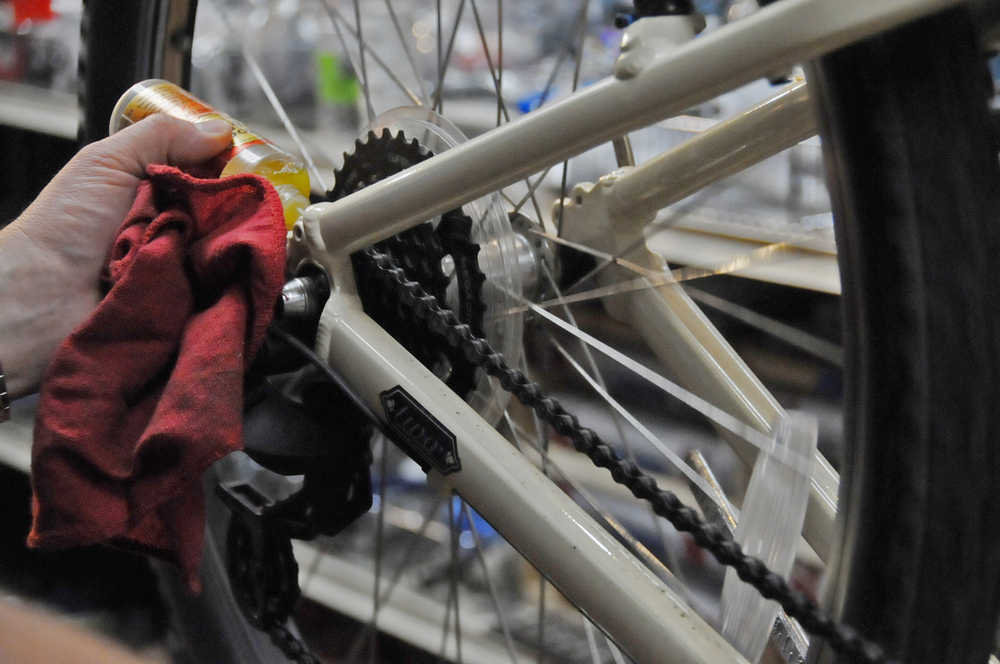When pulling mountain bikes out for the first time this spring, remember the ABCs: air, brakes, chain.
With the spring setting in and the ice clear from most of the roads, many Kenai Peninsula residents will be jumping on their bikes for the inaugural rides of the season. However, leaving a bike to sit all winter doesn’t mean it will be in the same shape in April as it was in October.
Deflated tires, stiff chains, dented wheels and rust can set in, depending on how a bike is stored throughout the winter. Bikes stored outside can see the worst of it, with water dripping down and either rusting the parts or getting inside the frame, freezing and damaging the frame itself.
Spring is a busy time for bike tuneups at Beemun’s Bike and Ski Loft. The bikes the mechanics see will run the gamut from fairly clean and in working order to sometimes unrideable, said Brad Carver, a mechanic at Beemun’s.
One of the first things the mechanics look for is poorly inflated tires. The tubes may be intact, but they leak air anyway, he said.
“Most people don’t realize that air is leaking all the time,” Carver said. “A lot of the flats we get are really just underinflated tires.”
The first thing mechanics look for is the condition of the chain and derailleur, the mechanism on the rear wheel that allows riders to shift gears. The mechanics at Beemun’s use a medium lubricant and check the chain for stiffness, cleaning the grease from the side plates and keeping it to the rollers. That keeps the grease from building up in the derailleur unnecessarily, Carver said.
They will also add some lubricant to the pivot points, another part of the derailleur where there are two pieces of metal not welded together. This requires a drier lubricant, Carver said. The thicker the viscosity of the lubricant, the more it will stick to the chain in rainy or snowy conditions.
“If you’re mountain biking through wet, dirty conditions, then you use a wetter lube,” Carver said. “If you’re road riding, you use a drier lube.”
Wheels out of alignment can rub up against the brake pads, causing unnecessary wear and slowing a ride. Although they are strong vertically, a run-in with a rut or a ding from another cyclist can dent the wheel or spokes. However, that doesn’t always require a new wheel, Carver said.
“A lot of people will come in having tweaked their wheels, and they’ll assume they need a new one,” Carver said. “A lot of times, we can true them.”
Another common problem is splinters or dirt on the rim. These can damage the brake pads, wearing them out and making them less effective, Carver said. He runs a Scotch pad over the rim to remove any aluminum splinters and to clean it to preempt the problem.
Brakes themselves may require part replacement. On bikes in better shape, a spring tuneup may not take long, but some bikes need new chains, brake pads, cables or tubes. Brake pads come with notches that indicate when they need to be replaced, Carver said.
Mechanics will lubricate the cable during a spring tuneup as well to make sure everything moves smoothly. On bikes with a step-through frame, on which the top bar swings low rather than straight across, the brake cable can wear out faster because there is more distance between the handle and the brake, and thus resistance, Carver said.
“They have to beef them up so they’re strong,” Carver said. “Ideally, your brake route would be straight from the handle to the brake. Whenever you (re-route the brake cable), it just makes more resistance.”
In general, the most common issue Beemun’s sees in the spring is dirty bikes and underinflated tires. They will wash bikes for an additional fee, but it’s better to store things in good shape in the first place to prevent major issues from building up, he said. Proper storage can preeempt a lot of the problems that arrive when riders pull their bikes out for the first spring, he said.
“We always say the best time to get a tuneup is in the fall,” Carver said.
Reach Elizabeth Earl at elizabeth.earl@peninsulaclarion.com.

